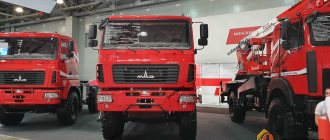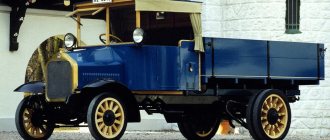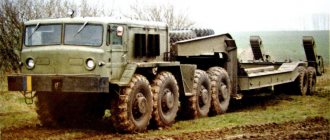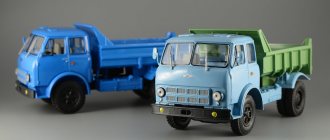Creating a truck: where it all began
By the end of the 19th century, individual engineers and inventors were actively working on how to improve the driving properties of carriages and carts. But a century earlier, in the 1780s, Russian inventor Ivan Kulibin built the so-called pedal carriage. By 1791, he introduced his self-propelled carriage, which could reach speeds of up to 16 km/h. Later, he tried to put a steam engine on his invention, but his death prevented the implementation of these plans. But the very idea of creating a car was already in the air and the first developments were picked up by other engineers and inventors.
The steam engine occupied a leading position for a long time, since at that time there were no suitable technologies and fuel for the internal combustion engine (ICE). Initially, the idea to create an internal combustion engine belonged to a scientist from the Netherlands, Christian Huygens. He expressed it already in 1678, but he suggested using gunpowder as fuel. There have been attempts to heat wood and the resulting gas, combined with air, to be used for an engine.
By the 70s of the 19th century, several types of internal combustion engines running on gasoline already existed. Such famous people as the German engineer Gottlieb Daimler and his friend from his youth Wilhelm Maybach . And by 1889 they assembled the first car. But how did the first truck come about? By chance.
By 1890, Gottlieb Daimler founded his company Daimler-Motoren-Gesellschaft and five years later produced about 1,000 engines. When the next experiment was carried out, the engineer decided to see how their engine would work on a heavy car. History is silent about the test results, but 1896 is considered the truck’s birthday .
A few years earlier, in 1883 the famous German engineer Karl Benz . The company produced gasoline engines. Here K. Benz designed his first car. With the development of the company, by 1902 the company introduced about 1000 trucks that were able to withstand loads of up to 250 kg.
Many years later, in order to overcome the financial crisis in Germany, the Karl Benz Daimler company merged to form the Daimler-Benz concern. Thus, since 1926, all jointly produced cars have been named “Mercedes-Benz”.
Surprisingly, the first practical users of trucks were firefighters. It was the firefighters who needed to quickly deliver not only rescuers, but also ladders, hoses, tools and water to the fire site. By the beginning of the century, similar machines began to appear in major cities around the world.
In Russia, the first fire engine was created in 1904 . It accommodated a crew of 10 firefighters, a pair of ladders, a hydrant and a hose. However, the car developed an extremely low speed, which was a significant drawback for people of this profession.
Although the beginning of the 20th century was marked by the emergence of a new type of transport, most transportation was still carried out by horse-drawn transport. Surprisingly, the first trucks were even slower than horse-drawn carts!
Factory-produced vehicles had high fuel consumption and low load capacity. Of course, in such a situation, the new transport was losing to the traditional horse on all fronts. However, this did not stop engineers and self-taught inventors; work was actively underway all over the world to improve the car engine and its carrying capacity.
Gradually the engines were improved and modernized. So, in 1907, a 4-cylinder gasoline engine was installed on one of the Daimler cars. Its power was 16 hp . Seven years later, the same company begins producing trucks with a more powerful engine of 35 hp. From the moment engineers managed to significantly improve engine power, truck production began to expand.
Trucks have long remained similar to cars. They had a similar design and engine. But with the beginning of the 20th century, the chassis became more massive, the body received a larger area, and the rear wheels became double. Moreover, trucks are beginning to be equipped with rubber tires . Previously, all cars used a pneumatic version. But, despite many innovations, freight transport was characterized by little comfort for drivers. Simply put, the car did not provide any amenities for the driver. Accordingly, few agreed to work in such conditions.
In parallel with the Daimler company, in 1903, German mechanical engineer Heinrich Büssing founded the company of the same name and began producing trucks, omnibuses and engines for them. It is from its mass production that trucks acquire the appearance that we can still see on the road.
In 1903 The world's first cars equipped with a transfer case . Nine years later, a driveshaft . The demand for trucks became greater and their popularity grew. Horse-drawn carriages gradually became a thing of the past, replaced by machines that were regularly improved. Trucks began to gain great popularity in the military sphere. So, since 1908, about 10 thousand cars were produced over 6 years.
However, driver convenience was still a big question. After the introduction of a closed cabin and equipping the vehicle with electrical equipment, the situation began to change for the better. gradually began to be introduced, the braking system was improved, and car tires were improved. This allowed the driver to feel more confident on the road.
Creation of a road train
The beginning of the twentieth century is the time of the birth of trucks. Today, trucks no longer surprise anyone, but a hundred years ago it was a big technical breakthrough. One of the most popular formats that can be found on the roads is the connection of a tractor with a trailer.
According to the definition: “ A road train is a structure consisting of a tractor vehicle and a trailer (trailer road train) or semi-trailer (semi-trailer road train, popularly called “truck” ).”
Incredibly, the creation of a variant of the vehicle with a coupling, the prototype of a modern road train, was possible thanks to one incident. In the 10s of the 20th century, Augustus Charles Fruehauf . He was an experienced craftsman in working with horse-drawn carriages, as well as wagons of various types. He soon gained sufficient popularity in his city. A. Fruehauf's business was going uphill and in 1914 one of his regular clients, Frederick Sibley, approached him. He was a fairly wealthy entrepreneur and at that time owned a Ford Model T. He needed to transport the boat to his home in northern Michigan, but a horse-drawn carriage would take several days to do this. At that time, the car could already reach a maximum speed of 72 km/h and F. Sibley asked Fruehauf to come up with a device so that he could pull the boat behind his car. A. Frühauf, together with his partner O. Neumann, took several days to think and the result was the appearance of the world's first semi-trailer. This was a real revolution of the twentieth century in the field of cargo transportation.
F. Sibley's updated car successfully transported the boat to its destination, and the businessman was so impressed that he immediately placed an order for several more similar cars with a semi-trailer. Later he used them for his business. A stream of orders poured into Fruehauf's workshop. Thus, in 1918 the Fruehauf Trailers Company of the same name was founded . Regularly mastering new technologies, the company very quickly became the largest manufacturer of semi-trailers in the world. the refrigerated semi-trailer was invented .
Henry Ford company did not lag behind its like-minded people . Created in 1903 , it focused on the production of passenger cars. However, later versions of the “miniature truck”, now called a “pickup”, were also presented to the world. The Ford company was the first in the world to introduce conveyor technology for assembling cars by 1913. And ten years later, every second car in America was manufactured at the plant named after. Ford.
Semi-trailers quickly became popular. By the 30s of the twentieth century, their number had increased more than 4 times, reaching an incredible figure by those standards - 25 thousand. in year.
KamAZ is the king of the roads
This car can rightfully be called the king of Russian roads. KamAZ-5320 is the main Soviet tractor-trailer designed for civil transport. The model first rolled off the assembly line of the Kama Automobile Plant in 1976 and became the first model produced under the KamAZ brand.
The prototype for the future 5320 was the ZIL-170. Based on KamAZ-5320 they produced:
— truck tractor — KamAZ-5410; — dump truck — KamAZ-5511; — extended flatbed truck — KamAZ-53212; — KamAZ-53213 chassis; — as well as a family of biaxial analogues.
The vehicle was equipped with a V-shaped eight-cylinder diesel engine from the Yaroslavl Motor Plant with a volume of 11 liters and a power of 210 or 180 hp. The maximum speed is 85 km/h, and fuel consumption is 35 liters per 100 km.
Photos from Internet resources
Truck in Russia
The appearance of the first trucks in Russia is associated with the name of Boris Grigorievich Lutsky , a Russian designer and developer of engines of various types. For some time he worked as a leading designer at Daimler. It was he who invented the world's first car with a vertical cylinder arrangement . In 1900 , he presented it at the World Exhibition in Paris and was awarded a silver medal. However, despite the improvement of the engine, the weight of the car itself remained very large. Without cargo, the weight reached almost 4 tons, and given that the quality of the roads was extremely poor, this was a significant disadvantage for the car. The speed that the car developed was 11 km/h. In the future, B. Lutsky will modernize his machines and reduce the weight to 2 tons.
It so happened that the activities of the Russian designer were connected with Germany. However, B.G. Lutsky always remembered his homeland and sought to benefit his state. In the same 1900, he turned to the military department in Russia and proposed to develop a car for the country's military needs. This proposal was accepted and within a couple of years the first such vehicles began to appear at the military’s disposal.
In 1914, returning from Russia, the famous designer was arrested. German authorities suspected him of espionage. With the outbreak of World War I, Lutsky was repeatedly offered to work for the German government, but he responded with a categorical refusal. For this reason, he had to spend several years in prison.
During the war, and even after it, the need for such cars grew steadily. However, it was not possible to make regular purchases abroad. It was decided to establish production on its territory.
In May 1929 , the USSR and the Ford Motor Company signed an agreement on cooperation in the production of trucks. From this date it is customary to count the beginning of the construction of the Gorky Automobile Plant in Nizhny Novgorod (formerly Gorky). The Ford-AA model was taken as a basis. And by 1932, the famous GAZ-AA (“one and a half”) was introduced. It was named a lorry for its tonnage of 1.5 tons.
However, unlike the American prototype, the Russian version of the GAZ-AA was slightly improved: the steering mechanism was strengthened, an air filter was installed, and an onboard body was designed. Despite the innovations, the car still needed improvement. Fuel consumption was high, and the vehicle's carrying capacity did not exceed 3-4 tons. Until 1934, the materials for the cabin were wood and pressed cardboard, later it was replaced with metal.
In parallel with the GAZ-AA car, in 1931, the first experimental tractor AMO-3 with a 6-cylinder engine with a load capacity of 2.5 tons was assembled at Moskovsky Automobile. The maximum speed of the truck was 50 km/h. In subsequent years, more and more advanced modifications of this machine will be created. Since 1933, the AMO plant received a new name ZIS (“Stalin Plant”).
In 1934, the Ya-12d tractor was designed at the Yaroslavl automobile plant which could tow a semi-trailer with a load capacity of 10 tons. The Ya-12D with a load could reach a speed of 48 km/h. The fuel consumption of the loaded car was 46-57 liters per 100 km. roads, the indicator depended on the quality of the roads. However, the engine and some other components were still of foreign production. And the plant itself was not technically equipped for serial production of the required number of cars. For these reasons, mass production of such a truck was never established.
In 1935, the Stalin Automobile Plant (ZIS) produced the new ZIS-10. The first domestic truck tractor! The three-ton ZIS-5 was taken as the basis for it, the load capacity increased to 6 tons, and the total weight of the tractor was about 28 tons. At that time, this was the maximum possible weight for loading the tires. With a power of 73 hp. The speed of the car did not even reach 50 km/h. Maneuverability was poor, and to turn around it was necessary to choose a road 9 meters wide. But, since no one could offer a better option at that time, this sample was put into production. It should be noted that in the pre-war period, the production of trucks was extremely slow. For 5 years, right up to the start of the Second World War, about 766 vehicles were produced. The issue of the shortage of semi-trailers was still quite acute.
have been made to establish the production of semi-trailers since 1937 at a plant near Leningrad. But for such production, prison labor was used, there were no technical conditions and everything was done almost by hand. Thus, the ZiS-10 was produced exclusively with an onboard wooden semi-trailer. It was extremely difficult to work on it. The car was slow and underpowered. In winter, slippery roads added to the problems, the wheels often slipped, and the braking system worked poorly.
Particularly interesting by this time were attempts to develop a completely new type of truck based on the principle of a road train. Since 1939, the Scientific Automotive and Tractor Institute (NATI) tried to design a car according to the “tractor-semi-trailer and trailer” scheme. Such a truck was supposed to simultaneously transport 6 GAZ-AA vehicles. First of all, such a development was due to savings. It was assumed that such technology would minimize fuel consumption and only one driver would be required to operate such a vehicle. The tests took place already in 1940. Six GAZ-AA vehicles had to be transported from Gorky to Moscow. This task was entrusted to the ZIS-10 tractor, which was previously equipped with an 85 hp engine. The distance between the cities was 400 km; the road train covered this route in almost 2 days. At the same time, fuel consumption per 100 km was about 65 liters. It was obvious that the ZIS-10 could not bear such a load. A little later, there were attempts to develop a more successful design for the same car, but in vain.
By the 40s of the twentieth century, car production already had a clear division into cars and trucks. Designers are improving the load-carrying capacity of machines, working on their speed and ease of use. However, the engine was still very noisy, and in winter conditions starting it became a real challenge. The active development of the truck industry was hindered by the war that began in 1941.
KrAZ-255 - “Laptezhnik”
A heavy all-terrain truck with a 6 x 6 wheel arrangement is designed to transport goods and people along roads and destinations. Production of the truck began in 1967 at the Kremenchug Automobile Plant. Until 1993, 160,732 cars were produced. For its excellent technical qualities, in 1975 the KrAZ-255B was awarded the state “USSR Quality Mark”.
The main civilian use of the Ural-373 was as a timber carrier, a tractor in vehicle depots and at airfields, as well as in the oil and gas industry. The vehicle was equipped with a V-shaped four-stroke eight-cylinder diesel engine YaMZ-238 with a volume of 15 liters and a power of 240 hp. The maximum speed is 70 km/h, and fuel consumption is 70 liters per 100 km. The vehicle could easily overcome fords up to 1 meter deep. It got its nickname “Laptezhnik” because of the VI-3 wide-profile tires installed on it.
USSR trucks in wartime
The war radically changed all areas of production. Factories that produced cars had to urgently adapt to a military format. Along with the production of vehicles, we had to master the production of weapons and ammunition.
Some enterprises were evacuated inland, to the Urals. Some stayed and worked to the best of their abilities. The director of the Moscow ZIS, I.A. Likhachev, was even allocated a separate plane on which he could travel between evacuated automobile factories in the Urals, the Volga region and Moscow. Famous trucks of the war years : GAZ-MM, GAZ-AAA, ZIS-5, ZIS-6, ZIS-30, YAG-6, etc. They were used on the famous “Road of Life”, which passed to besieged Leningrad. Advantage was given to the first two types due to their lighter weight. During their work, they were able to deliver a huge amount of cargo, food and evacuate about a million residents. During the war years, models such as the ZIS-5 and GAZ-MM were produced in a simplified form : there was no front bumper, brakes were only on the rear wheels, the side of the body could only be opened from the rear. This would minimize material shortages and speed up the pace of assembly.
Simple in design and unpretentious in terms of fuel quality, wartime trucks had fairly good maneuverability. They rescued soldiers more than once during hostilities. Even the German army appreciated them and actively used our vehicles in the occupied territories. In 1943, the State Defense Committee decided to transfer the assembly of ZIS vehicles to the Urals, to the city of Miass. Since July 1944, the Ural Automobile Plant has been producing its first truck, the ZIS-5v.
Truck in the post-war period
With the end of the war, freight transport was used to the maximum on the territory of the USSR. Restoration work was in full swing, the country was eliminating the consequences of the war, and the transportation of heavy cargo became more important than ever.
At the Gorky Automobile Plant in the 2nd half. In the 50s, such models of trucks as GAZ-56 (with a load capacity of 1.5 tons), GAZ-52 (2.5 tons) and GAZ-53 (3.5 tons) were prepared for production. By the early 60s, the plant managed to introduce a new generation of GAZ trucks. The all-wheel drive vehicle became the first to be awarded the state quality mark.
By the end of the 50s, the Ural Automobile Plant launched the production of the 2-axle truck Ural ZIS-355M, which was subsequently actively used in the development of the virgin lands of Kazakhstan and Siberia. In 1961, heavy-duty off-road trucks Ural-375 . For this development, the plant received a 1st degree VDNKh diploma.
Another famous model belongs to the production of the Minsk Automobile Plant. MAZ-YAZ-200 was assembled as prototypes at the Yaroslavl Automobile Plant (YAZ) in the last years of the war, and their mass production began in the 50s. The car's cabin was a wooden frame covered with clapboard, and the power reached 110 hp. The car could reach speeds of up to 52 km/h. At the same time, a version of a truck for military needs was presented, where the seats could recline to transport people, and an awning could be attached to removable arches. On the basis of the YAZ-200, the MAZ-501 all-wheel drive timber truck and the MAZ-205 dump truck are being developed. This Soviet heavy dump truck was produced until 1965. And already on its basis, various enterprises produced vehicles with two-way unloading of the body, vehicles for transporting mortar, cement, fire tanks, etc.
The 70s were marked by a large-scale reorganization of production, which was carried out at the Gorky Automobile Plant. As a result of the transformations carried out, the GAZ PA was formed; it included 11 plants. GAZ begins development of a new truck and by 1984 introduces the GAZ-4301 , equipped with an air-cooled diesel engine . And by the end of the 80s, test samples were being produced, a prototype of the famous Gazelle brand. Since the war, the truck, released in 1994 , became the first GAZ lorry to enter mass production. Today, such a machine is extremely popular among representatives of business and trade and is found everywhere.
With the collapse of the USSR, many industries, including the automotive industry, experienced difficult times. Once again, global changes were required, which each enterprise carried out in its own way. Thus, since 1995 , Ural AZ and the Italian automaker Iveco organized a joint production to produce heavy trucks. Dump trucks, truck tractors, and timber trucks were manufactured under license from Italian partners. Some of the equipment was exported, expanding its sales geography every year.
With the opening of borders, Czech heavy-duty trucks and Tatra dump trucks began to appear more and more often on Russian roads. Commercial tractors of the Mercedes-Benz brand confidently occupy their niche in the market, also thanks to the long history of the company. What is noteworthy is that it was on the basis of the Mercedes brand of the 50s that Indian manufacturers created the TATA light-duty truck, which is now very popular. Volvo, Ford, Hyundai, Scania, MBL Motors are also keeping up with their competitors. Today, a modern car comes equipped with various electronic devices that help on the road. The process of coupling a semi-trailer with a tractor is easy and quick; with its impressive dimensions, any road train can move at a decent speed. The cargo is delivered quickly, significantly saving time.
The modern appearance and equipment of a truck is the result of the work of many people, ten years of trial and error. This is a colossal work that began a long time ago and continues to this day. Today, even the most specific cargo can be delivered to any distance. But progress does not stand still and the truck industry regularly introduces newer and more modern developments.
GAZ-51 - rural worker
A prototype of this machine was created during the war. The first mass production began in 1946. Ten years later, in 1955, they began producing a modernized version of the GAZ-51A, which was produced until 1975. In total, almost 3.5 million trucks of all modifications rolled off the assembly line.
GAZ-51 was produced under Soviet license:
- in Poland at the FSC plant - the model was called “Lublin-51” (GAZ Lublin-51); - in North Korea, as Seungri-58 (Sungri-58); - in China, as Yuejin NJ130.
GAZ designers managed to create a worthy replacement for the lorry. The load capacity was increased by one and a half times - up to 2500 tons, and the service mileage doubled. All components and assemblies had a decent margin of safety and could withstand serious overloads.
The car was equipped with a six-cylinder engine of the same name with a volume of 3.5 liters and a power of 70 hp. Maximum speed is 70 km/h.











